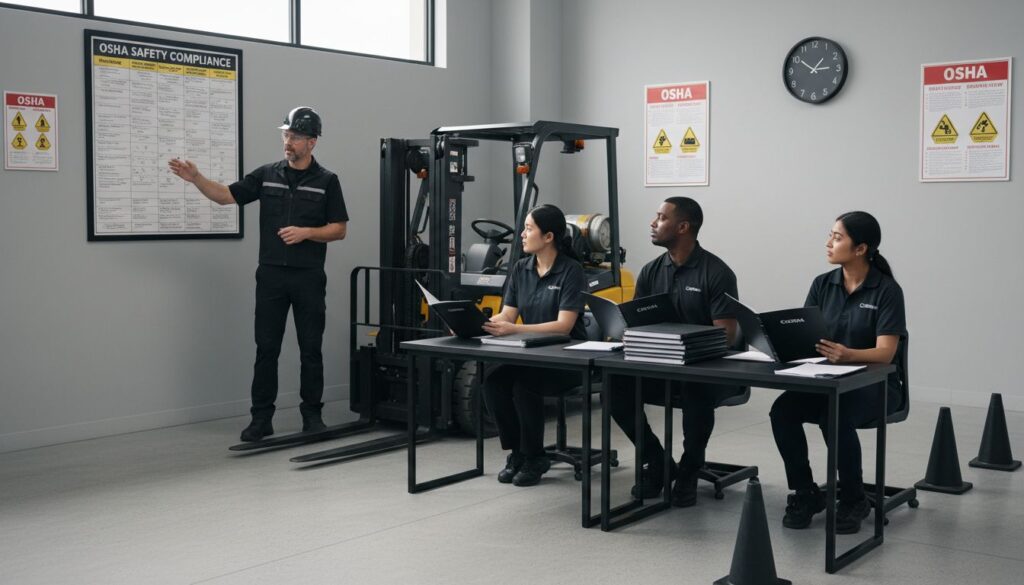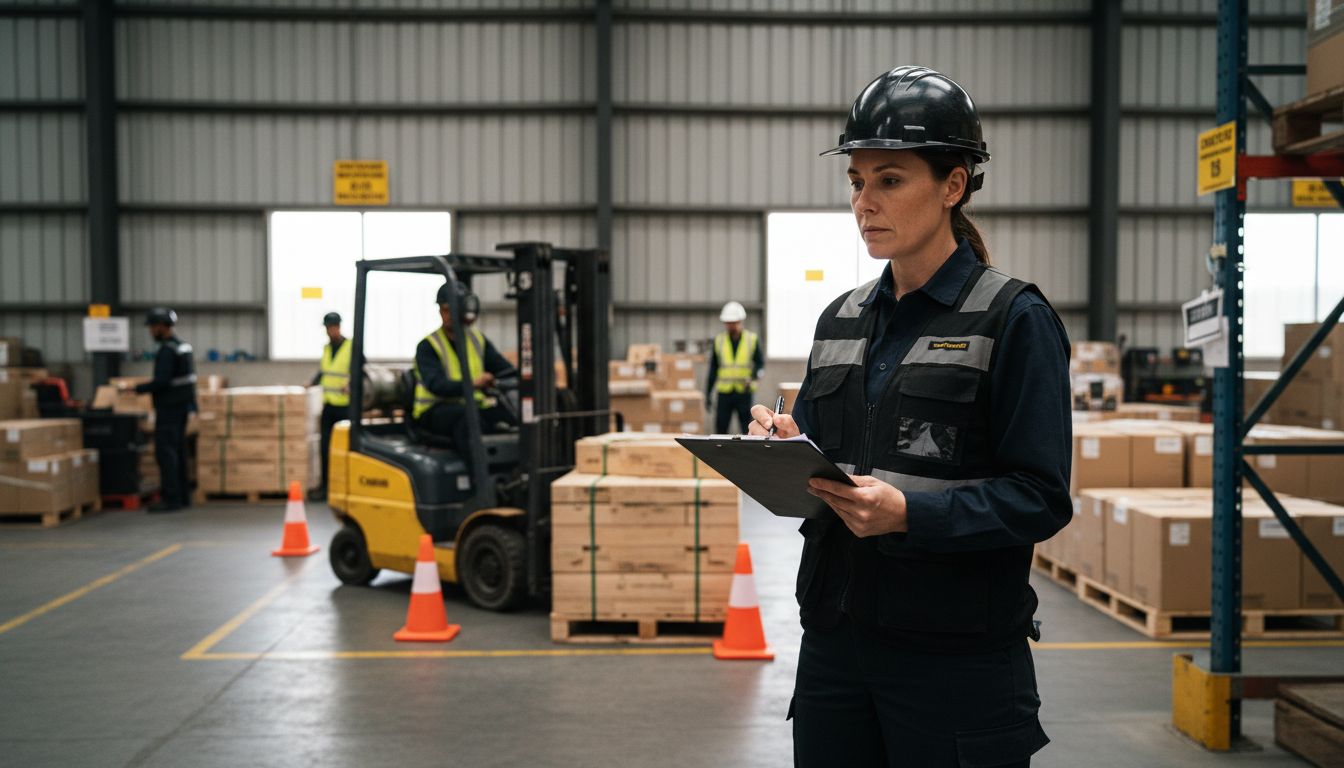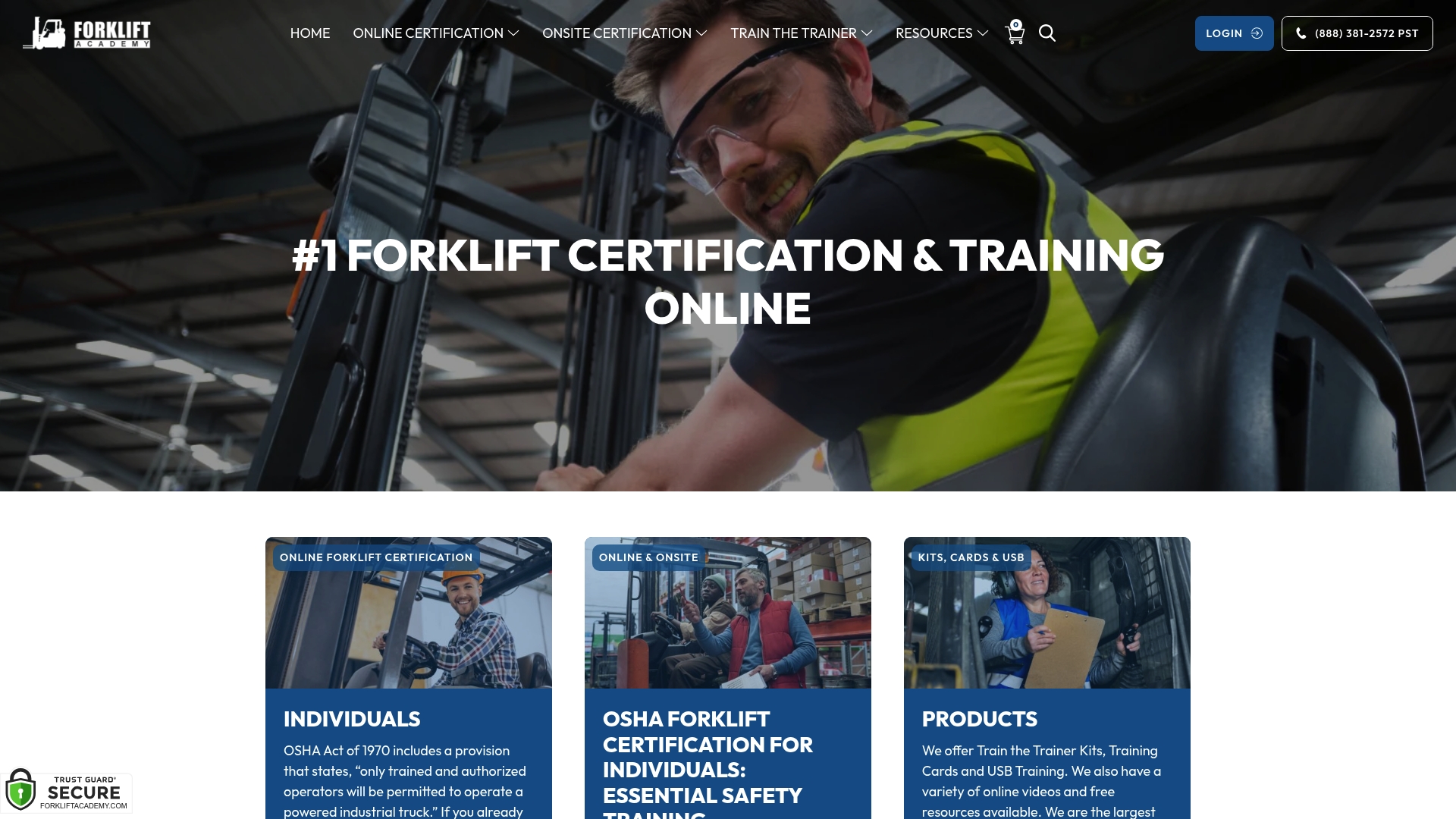
Every year, forklift accidents claim over 85 lives and lead to nearly 35,000 serious injuries in workplaces across the United States. These startling numbers show how crucial proper operator training is for keeping employees safe and meeting legal requirements. With strict OSHA regulations in place, knowing the standards for forklift trainer certification helps businesses avoid costly penalties, reduce liability, and create safer work environments for everyone on site.
| Point | Details |
|---|---|
| OSHA Compliance is Mandatory | Employers must adhere to OSHA regulations, necessitating comprehensive training programs for forklift operators to ensure safety and competency. |
| Certification Process Involves Three Components | The forklift certification process includes formal instruction, practical training, and performance evaluation to verify operator capability. |
| Documentation is Essential | Accurate record-keeping of training, evaluations, and certifications is vital for legal compliance and risk management. |
| Regular Refreshers are Required | Operators need refresher training and evaluations every three years or sooner if work conditions change to maintain safety standards. |
Forklift trainer certification represents a critical component of workplace safety and regulatory compliance. OSHA regulations mandate strict guidelines for training powered industrial truck operators, ensuring that only competent and thoroughly trained professionals can operate these complex machines. According to OSHA’s official guidelines, employers must develop comprehensive training programs that cover multiple critical dimensions of forklift operation and safety.
The certification process involves three essential components: formal instruction, practical training, and performance evaluation. This multi-stage approach ensures that operators don’t just learn theoretical knowledge but can demonstrate practical skills in real-world workplace environments. Effective training covers crucial areas such as understanding different forklift types, identifying workplace hazards, comprehending pre-use inspection requirements, and mastering safe operating practices.
Key certification standards typically include:
Professional certifications like the Forklift Train the Trainer Process provide advanced training that not only qualifies operators but also prepares professionals to teach and certify others. These programs often require periodic renewal, typically every three to five years, ensuring that trainers stay updated with the latest safety standards and technological advancements in industrial equipment operation.
Understanding the legal framework for forklift training is crucial for workplace safety and regulatory compliance. OSHA Standard 29 CFR 1910.178(l) establishes comprehensive requirements that employers must follow when training powered industrial truck operators. According to OSHA Compliance Guidelines, the regulations mandate a rigorous three-part training program designed to ensure comprehensive operator competence.
The legal requirements are structured around three critical components:
Specifically, employers must develop training programs that comprehensively cover:
OSHA and ANSI standards require detailed documentation for each operator certification.
 This documentation must include the operator’s name, specific training and evaluation dates, and the credentials of the individuals conducting the training. OSHA Compliance Navigating Requirements emphasize that these certifications are not just recommended but legally mandatory, with employers bearing direct responsibility for ensuring comprehensive operator training and workplace safety.
This documentation must include the operator’s name, specific training and evaluation dates, and the credentials of the individuals conducting the training. OSHA Compliance Navigating Requirements emphasize that these certifications are not just recommended but legally mandatory, with employers bearing direct responsibility for ensuring comprehensive operator training and workplace safety.
The forklift certification process is a structured journey that transforms an individual from a novice to a qualified professional operator. According to How to Get OSHA Forklift Certification, the process involves multiple critical stages designed to ensure comprehensive training and workplace safety.
The certification journey typically follows these systematic steps:
OSHA regulations mandate that employers conduct comprehensive documentation for each certified operator. This documentation must include the operator’s name, specific training and evaluation dates, and the credentials of trainers. Critically, certification is not a one-time event. According to OSHA guidelines, operators must undergo refresher training and performance evaluation at least once every three years, or sooner if workplace conditions change, unsafe operation is observed, or an accident occurs.
The ultimate goal of this meticulous certification process is not just compliance, but creating a culture of safety where operators understand the profound responsibility of managing powerful industrial equipment. Proper certification ensures that every forklift operator has the knowledge, skills, and awareness to protect themselves and their colleagues in dynamic workplace environments.
Forklift trainer certification programs come in diverse formats designed to meet varying organizational and individual learning needs. What is a Train the Trainer Program explains that these programs fundamentally aim to create qualified professionals who can train and certify other forklift operators within their workplace.
The most common types of forklift trainer programs include:
Here’s a comparison of the most common forklift trainer program types:
| Program Type | Format | Key Advantages |
|---|---|---|
| Online Certification | Digital/Self-paced | Flexible scheduling Accessible anywhere |
| Hybrid Training | Online + In-person | Combines flexibility and hands-on practice |
| Onsite Training | In-person at facility | Customizable Practical workplace relevance |
| Train-the-Trainer | Advanced/In-person or hybrid | Develops internal trainers Meets OSHA needs |
| Industry-Specific | Customized/In-person or hybrid | Tailored for specific environments |
Each program type offers unique advantages, but all must meet stringent OSHA compliance standards. Typically, these programs cover critical areas such as equipment mechanics, safety protocols, operational guidelines, and legal responsibilities. Successful completion requires demonstrating both theoretical knowledge and practical skills through comprehensive evaluation processes.
The ultimate goal of these diverse training approaches is creating a robust safety culture. Whether an organization chooses online, onsite, or hybrid training, the core objective remains consistent: ensuring that every forklift operator possesses the knowledge, skills, and awareness to operate industrial equipment safely and efficiently.
Forklift training is more than a procedural requirement—it’s a critical safety imperative with significant legal and financial implications. Understanding OSHA Compliance reveals that employers bear substantial responsibility for preventing workplace accidents through comprehensive training and ongoing operator evaluation.
Common mistakes that expose organizations to significant risks include:
Employers face potential legal consequences ranging from hefty OSHA fines to civil liability in case of workplace accidents. Potential risks include worker compensation claims, legal settlements, increased insurance premiums, and potential criminal negligence charges if serious safety violations are discovered. Proactive training and meticulous documentation are the most effective strategies for mitigating these substantial financial and legal vulnerabilities.
The stakes are high. A single untrained or improperly certified forklift operator can create catastrophic risks—potential injuries, equipment damage, productivity losses, and devastating legal repercussions. Investing in comprehensive, OSHA-compliant training is not just a regulatory requirement, but a fundamental commitment to workplace safety and organizational resilience.
Forklift trainer certification is more than just a box to check. It is about mastering OSHA compliance, avoiding costly liabilities, and building a safety culture that protects everyone on site. You know the challenges: ensuring thorough formal instruction, effective hands-on practical training, and rigorous performance evaluation — all while keeping detailed documentation and adapting to workplace changes. These hurdles can be overwhelming without the right support, especially when legal responsibilities and employee safety are on the line.

Get the trusted guidance and proven solutions you need at Forkliftacademy.com. Whether you are seeking individual certification or comprehensive forklift training programs for your team, our platform offers flexible online, onsite, and train-the-trainer options tailored to meet OSHA standards. Don’t risk compliance gaps or safety oversights. Visit Forklift Certification Archives to explore detailed training resources and start transforming your forklift program today. Take the crucial next step in workplace safety by partnering with industry veterans who prioritize your success.
The forklift trainer certification process consists of three essential components: formal instruction, practical training, and performance evaluation.
Forklift operator certification typically requires renewal every three to five years, with refresher training needed sooner if workplace conditions change or unsafe operation is observed.
OSHA mandates a three-part training program for forklift operators that includes formal instruction, practical training, and performance evaluation, all of which must be documented.
Common types of forklift trainer programs include online certification, hybrid training, onsite training, train-the-trainer programs, and customized industry-specific programs.